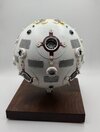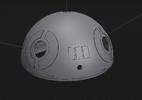With both the hemispheres printed I had to insert the magnet and see how it floated, and I have to say I'm happy with it. It floats a bit higher than the first one, and the base looks a bit classier.
Check out the detail on that nub on top (as mentioned in
this post), it's not the original Plastruct hemispheres, but it's pretty close!
Size comparison with the first training remote.
When gluing in the magnet I actually used Milliput to have some working time to adjust it so that the training remote rotated very straight on an imaginary vertical axis. I even used a laser level, but that was a bit overkill. I found better results fine tuning while watching the nub on top against a busy background, to see if it moved horizontally at all. I fine tuned it so the nub on top looked like it didn't move from side to side at all.
Again with the first training remote by its side for comparison.
With the magnet and lights plus coil glued in place I masked off the lights and sprayed the inside white so it will reflect more light and what light that comes out will hopefully seem brighter. I also glued in some small shims to help with alignment when gluing the hemispheres together.
I then was ready to glue the hemispheres together. I used super glue as I was impatient. I in fact was so impatient I even used it as a gap filling medium, adding a thick bead along the equator and curing it with activator spray. All the while thinking "this is probably what they would have done at ILM back in the seventies", to justify being so nonchalant.
Afterwards I sanded it smooth.
Then came the fun part where the prop really comes to life, gluing on the greeblies.
It's starting to look like something.
I sanded some clear plastic I had laying around to make it opaque, then cut out circles to put behind the commander's hatches.
Next up was gluing on the "styrene" pieces along the equator (I had decreased them in size by 1mm horizontally and 0,5mm vertically from the first training remote as I thought they were a hair too big), and at last give it a unifying coat of primer. In this case I used Citadel Wraithbone on a rattle can, as I had it on hand.
Note the tissue paper stuffed in the commander's hatches to mask out the opaque "windows".
Again a comparison with the first training remote.
And this is as far as I've come at the moment. Next up is an airbrush coat of Reefer White, and painting the rest of the details and weathering it!


